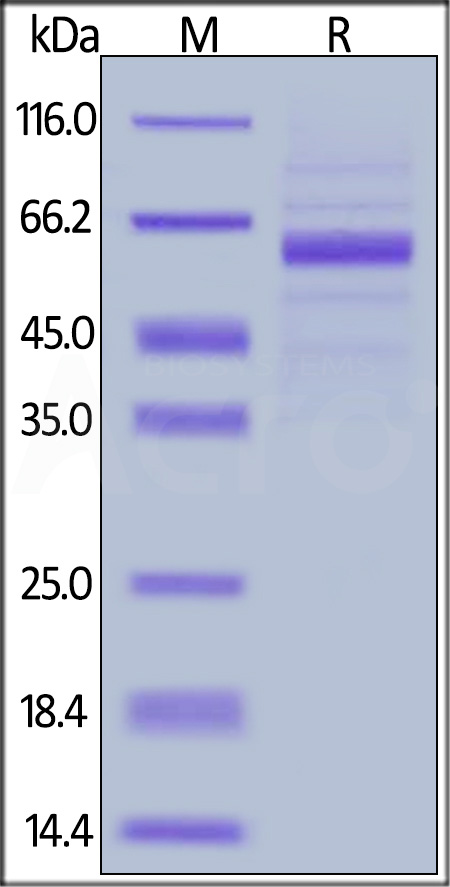分子别名(Synonym)
CLEC4G,LSECtin
表达区间及表达系统(Source)
Human LSECtin, Fc Tag (CLG-H5250) is expressed from human 293 cells (HEK293). It contains AA Lys 55 - Cys 293 (Accession # Q6UXB4-1).
Predicted N-terminus: Glu
Request for sequence
蛋白结构(Molecular Characterization)

This protein carries a human IgG1 Fc tag at the N-terminus.
The protein has a calculated MW of 52.1 kDa. The protein migrates as 58-66 kDa under reducing (R) condition (SDS-PAGE) due to glycosylation.
内毒素(Endotoxin)
Less than 1.0 EU per μg by the LAL method.
纯度(Purity)
>85% as determined by SDS-PAGE.
制剂(Formulation)
Lyophilized from 0.22 μm filtered solution in 50 mM Tris, 100 mM Glycine, pH7.5. Normally trehalose is added as protectant before lyophilization.
Contact us for customized product form or formulation.
重构方法(Reconstitution)
Please see Certificate of Analysis for specific instructions.
For best performance, we strongly recommend you to follow the reconstitution protocol provided in the CoA.
存储(Storage)
For long term storage, the product should be stored at lyophilized state at -20°C or lower.
Please avoid repeated freeze-thaw cycles.
This product is stable after storage at:
- -20°C to -70°C for 12 months in lyophilized state;
- -70°C for 3 months under sterile conditions after reconstitution.
电泳(SDS-PAGE)

Human LSECtin, Fc Tag on SDS-PAGE under reducing (R) condition. The gel was stained with Coomassie Blue. The purity of the protein is greater than 85%.
文献引用(Citations)
Authors: X Yu, et al
Journal: MAbs 2019
Application: ELISA
Antibodies binding lag-3 and uses thereof
Authors: X Kang, et al
Journal: US20190016800A1 2019
Application: ELISA
背景(Background)
C-type lectin superfamily 4, member G (CLEC4G) is also known as liver and lymph node sinusoidal endothelial cell C-type lectin (LSECtin), which is a member of subgroup II of the C-type (Ca2+-dependent) lectin superfamily. CLEC4G / LSECtin binds to mannose, GlcNAc, and fucose in a Ca2+-dependent manner. In addition, CLEC4G / LSECtin has the ability to bind to surface glycoproteins of enveloped viruses. In particular, interaction of LSECtin with the surface glycoproteins of severe acute respiratory syndrome (SARS) coronavirus and Ebola virus has been described, and LSECtin-mediated infection of cells by Ebola virus has been demonstrated.























































 膜杰作
膜杰作 Star Staining
Star Staining











